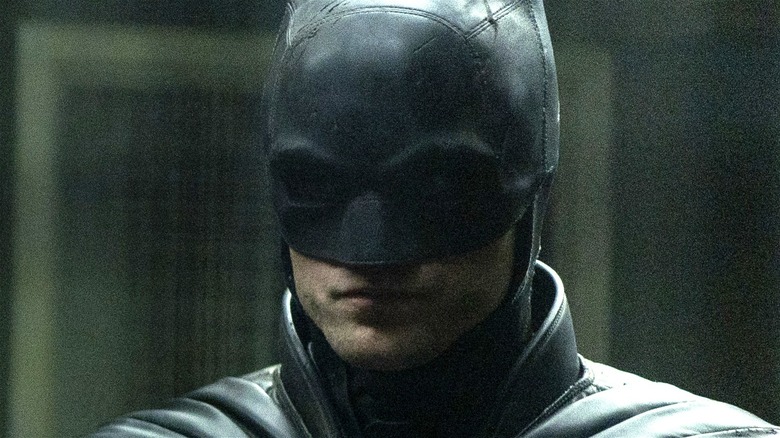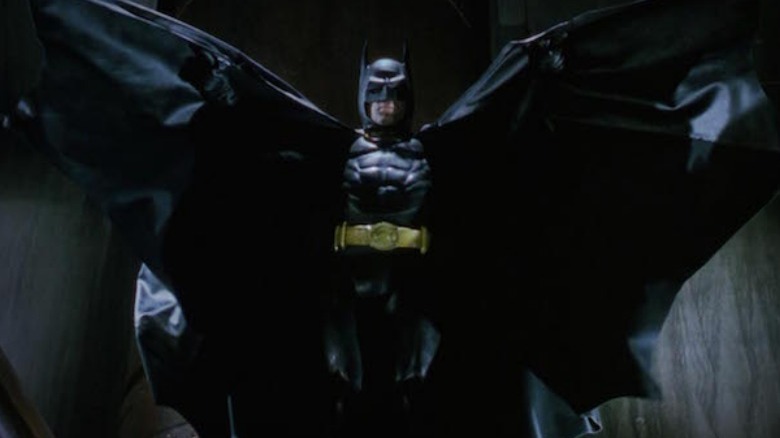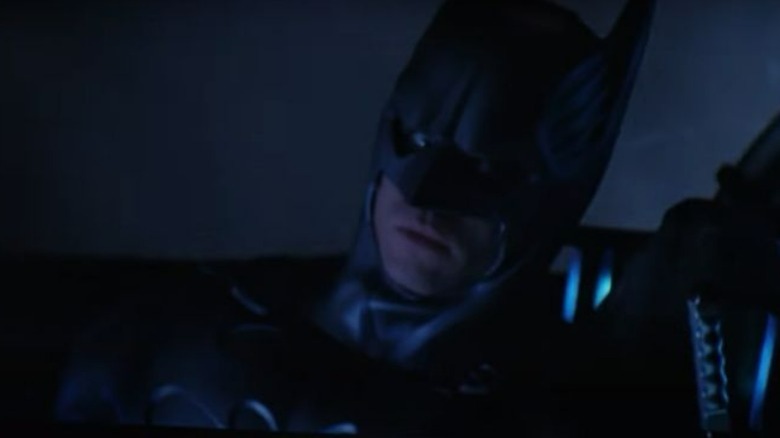Why Batman's Costume Makes No Sense According To Science
Over the past 80-plus years, Batman has more than earned his place as a comic book legend for more reasons than one. He boasts a remarkable rogues' gallery — ranging from the Joker to Clayface –, he's a key component of super-teams like the Justice League, and he's a merchandising juggernaut and has been for decades. Although, when talking about what makes the Dark Knight so memorable, one would be remiss not to highlight an undeniably important element of his legacy: the Batsuit and the numerous variations he has adopted during his years of fighting crime.
As long as there's been a Batman, there's been a Batsuit in some form or fashion. Some are cloth, and some are rubber. Some are armored, and some are lightweight. They come in a range of color schemes, ear and cape lengths, and utility belt sizes. Regardless of the specifics, though, Batman rarely leaves the Batcave without one when he's going off to fight crime. His suits go a long way in keeping him safe, and they're useful in striking fear into the hearts of Gotham City's criminals. Not to mention, most of them are pretty badass and ripe with cosplay potential.
Still, for as awesome as many of Batman's costumes are, they're far from perfect. Especially when placed into a real-world context, some life-threatening issues begin to present themselves. Arguably one of the most glaring was examined by physicists, who explained why it wouldn't work in real life as it does in the comics, cartoons, or movies.
Using a cape to glide around isn't exactly safe
As noted previously, the majority of Batsuits are incomplete without a cape. After all, Batman hasn't earned the "Caped Crusader" nickname for nothing. On the surface, it looks like nothing more than an aesthetic choice, but in truth, many Batman incarnations have used the cape for much more than meeting the guidelines of modern superhero fashion. Aside from using it as a means of intimidating Gotham's criminals, it has been adapted into a bullet shield and even as a method of gliding across large distances. The former seems possible with a durable material like Kevlar, but the latter isn't nearly as plausible in reality.
"Clearly gliding using a Batcape is not a safe way to travel, unless a method to rapidly slow down is used, such as a parachute," wrote physicists at the University of Leicester in the "Journal of Special Physics Topics" publication back in 2012 (via Wired). They note that after leaping from a 150-meter-high Gotham City skyscraper, Batman could realistically glide for approximately 350 meters on a 4.7-meter wingspan before the velocity levels off at 110km/h. At that point, an 80km/h descent begins that the DC Comics mainstay would more than likely die from without something to break the fall.
Granted, this study didn't account for any variation in the angle of this hypothetical glide, but still, that information sure takes some of the fun out of Batman media, doesn't it?
The cape isn't the only impractical element of the Batsuit
All in all, there's nothing wrong with pretending that Batman can use his cape to glide from building to building. It's a fun mechanic to use in the "Batman: Arkham" video games, and it sets up some neat visuals on the big screen. In fact, one could easily label another Batsuit element as even more impractical than his cape: his cowl. Specifically, those worn by the likes of Michael Keaton, Val Kilmer, George Clooney, and Christian Bale for one or all of their live-action movie appearances, which present a seriously immersion-breaking issue of their own.
Seeing as these specific cowls were one solid piece from the shoulders up, turning one's head proved no easy feat. At a press event for "Robocop" in 2014 (via Desde Hollywood on YouTube), Michael Keaton spoke on his struggles with the headpiece while filming 1989's "Batman," revealing that moving his head at the neck was next to impossible. Thus, he had no choice but to move his entire upper body for moments where Batman had to turn and look in a different direction. That's inconvenient for an actor, let alone someone trying to fight off two or three bad guys at once.
From cape to cowl, the Batsuit is something of a mess by real-world standards, yet it's typically presented as the ultimate suit of armor at the cinema, on TV, and on the pages of DC Comics. At the end of the day, though, suspension of disbelief is the name of the game with these forms of media. As long as it looks cool, that's all that really matters.


